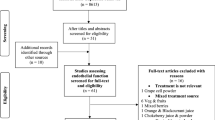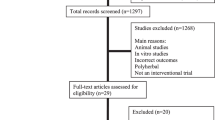Abstract
Purpose
Wolfberry is rich in bioactive compounds which may lower cardiovascular disease risk. This meta-analysis aimed to systematically evaluate the effects of wolfberry-based randomized controlled trials (RCTs) on overall cardiovascular health.
Methods
Four online databases (PubMed, CINAHL Plus, Medline and Cochrane Library) were searched to shortlist relevant RCTs. Outcomes of interests included blood lipids and lipoproteins, blood pressure, biomarkers of oxidative stress, inflammation and other cardiovascular health-related indicators. Random-effects models were used to provide a weighted mean difference (WMD) and/or Hedges’ g for quantitative synthesis. This was coupled with subcategory analyses which stratified RCTs according to the form in which wolfberry was administered (whole wolfberry versus wolfberry extract).
Results
From the 785 articles identified, 10 were selected for meta-analysis. Compared to the control, groups which consumed wolfberry showed a reduction in blood triglycerides [WMDpooled (95% confidence interval): − 0.14 (− 0.19, − 0.09) mmol/L] and increased blood high-density lipoprotein cholesterol [WMDpooled: 0.06 (0.02, 0.09) mmol/L]. Notably, effects for both triglycerides [WMDwhole: − 0.14 (− 0.19, − 0.09) mmol/L; WMDextract: − 0.07 (− 0.30, 0.16) mmol/L] and high-density lipoprotein cholesterol [WMDwhole: 0.06 (0.02, 0.09) mmol/L; WMDextract: 0.05 (− 0.02, 0.13) mmol/L] were more prominent after whole wolfberry interventions. Additionally, blood malondialdehyde equivalents were also significantly decreased in wolfberry consuming groups [Hedges’ gpooled: − 1.45 (− 2.75, − 0.16)]. No changes were observed for the other lipids and lipoproteins as well as blood pressure.
Conclusions
Wolfberry consumption is effective in improving blood lipids and lipoproteins profile and lowering oxidative stress. This supports the incorporation of wolfberry, particularly as whole fruits, into dietary patterns targeted at improving cardiovascular health.




Similar content being viewed by others
Data availability
Data from this research will be made available upon request.
References
Arnett DK, Blumenthal RS, Albert MA et al (2019) 2019 ACC/AHA guideline on the primary prevention of cardiovascular disease: a report of the American College of Cardiology/American Heart Association Task Force on clinical practice guidelines. Circulation 140:e596–e646
Zanchet MZS, Nardi GM, Bratti LOS et al (2017) Lycium barbarum reduces abdominal fat and improves lipid profile and antioxidant status in patients with metabolic syndrome. Oxid Med Cell Longev 2017:9763210
Cheng J, Zhou ZW, Sheng HP et al (2015) An evidence-based update on the pharmacological activities and possible molecular targets of Lycium barbarum polysaccharides. Drug Des Dev Ther 9:33–78
Potterat O (2010) Goji (Lycium barbarum and L. chinense): phytochemistry, pharmacology and safety in the perspective of traditional uses and recent popularity. Planta Med 76:7–19
Amagase H, Farnsworth NR (2011) A review of botanical characteristics, phytochemistry, clinical relevance in efficacy and safety of Lycium barbarum fruit (goji). Food Res Int 44:1702–1717
Konarska A (2018) Microstructural and histochemical characteristics of Lycium barbarum L. fruits used in folk herbal medicine and as functional food. Protoplasma 255:1839–1854
Lu Y, Guo S, Zhang F et al (2019) Comparison of functional components and antioxidant activity of Lycium barbarum L. fruits from different regions in China. Molecules 14:2228
Hempel J, Schädle CN, Sprenger J et al (2016) Ultrastructural deposition forms and bioaccessibility of carotenoids and carotenoid esters from goji berries (Lycium barbarum L.). Food Chem 218:525–533
Bucheli P, Gao Q, Redgwell R et al (2011) Biomolecular and clinical aspects of Chinese wolfberry. In: Benzie IFF, Wachtel-Galor S (eds) Herbal medicine: biomolecular and clinical aspects, 2nd edn. CRC Press/Taylor & Francis, California, pp 290–308
Wang CC, Chang SC, Inbaraj BS, Chen BH (2010) Isolation of carotenoids, flavonoids and polysaccharides from Lycium barbarum L. and evaluation of antioxidant activity. Food Chem 120:184–192
Pai PG, Umma HP, Ullal S et al (2013) Evaluation of hypolipidemic effects of Lycium barbarum (goji berry) in a murine model. J Nat Remedies 13:4–8
Luo Q, Cai Y, Yan J et al (2004) Hypoglycemic and hypolipidemic effects and antioxidant activity of fruit extracts from Lycium barbarum. Life Sci 76:137–149
Xin Y-F, Zhou G-L, Deng Z-Y et al (2007) Protective effect of Lycium barbarum on doxorubicin-induced cardiotoxicity. Phytother Res 21:1020–1024
Feng Z, Jia H, Li X et al (2010) A milk-based wolfberry preparation prevents prenatal stress-induced cognitive impairment of offspring rats, and inhibits oxidative damage and mitochondrial dysfunction in vitro. Neurochem Res 35:702–711
Zhao Z, Luo Y, Li G et al (2013) Thoracic aorta vasoreactivity in rats under exhaustive exercise: effects of Lycium barbarum polysaccharides supplementation. J Int Soc Sports Nutr 10:47–53
Wu H, Guo H, Zhao R (2006) Effect of Lycium barbarum polysaccharide on the improvement of antioxidant ability and DNA damage in NIDDM rats. Yakugaku Zasshi 126:365–371
Guo X, Li Z, Cai H, Li D (2017) The effects of Lycium barbarum L. (L. barbarum) on cardiometabolic risk factors: a meta-analysis of randomized controlled trials. Food Funct 8:1741–1748
Benzie IFF, Chung WY, Wang J et al (2006) Enhanced bioavailability of zeaxanthin in a milk-based formulation of wolfberry (gou qi zi; Fructus barbarum L.). Br J Nutr 96:154–160
Toh DWK, Xia X, Sutanto CN et al (2021) Enhancing the cardiovascular protective effects of a healthy dietary pattern with wolfberry (Lycium barbarum): a randomized controlled trial. Am J Clin Nutr 114:80–89
Ma JJ, Zhang WJ, Yang Y, Yuan XG (2019) Effects of Lycium barbarum polysaccharide on the immune function and antioxidant of taekwondo athletes. Chin J Appl Physiol 35:513–516
Singh U, Jialal I (2006) Oxidative stress and atherosclerosis. Pathophysiology 13:129–142
Moher D, Liberati A, Tetzlaff J et al (2010) Preferred reporting items for systematic reviews and meta-analyses: The PRISMA statement. Int J Surg 8:336–341
Higgins JP, Deeks JJ, Altman DG (2008) Special topics in statistics. In: Higgins JP, Green S (eds) Cochrane handbook for systematic reviews of interventions: cochrane book series, 5.0.1. Wiley-Blackwell, Chichester, pp 481–530
Amagase H, Sun B, Borek C (2009) Lycium barbarum (goji) juice improves in vivo antioxidant biomarkers in serum of healthy adults. Nutr Res 29:19–25
Toh DWK, Lee WY, Zhou H et al (2021) Wolfberry (Lycium barbarum) consumption with a healthy dietary pattern lowers oxidative stress in middle-aged and older adults: a randomized controlled trial. Antioxidants 10:567
Lee YJ, Ahn Y, Kwon O et al (2017) Dietary wolfberry extract modifies oxidative stress by controlling the expression of inflammatory mRNAs in overweight and hypercholesterolemic subjects: a randomized, double-blind, placebo-controlled trial. J Agric Food Chem 65:309–316
Higgins JP, Altman DG (2008) Assessing risk of bias in included studies. In: Higgins JP, Green S (eds) Cochrane handbook for systematic reviews of interventions: cochrane book series, 5.0.1. Wiley-Blackwell, Chichester, pp 187–242
He J, Zhou W, Qiu Y et al (1998) A clinic study in the effect of Lycium barbarum L. on antioxidixing reaction in the patients with diabetic retinopathy. Tradit Chin Opthalmol 5:1998–2002
Cai H, Liu F, Zuo P et al (2015) Practical application of antidiabetic efficacy of Lycium barbarum polysaccharide in patients with type 2 diabetes. Med Chem 11:383–390
Vidal K, Bucheli P, Gao Q et al (2012) Immunomodulatory effects of dietary supplementation with a milk-based wolfberry formulation in healthy elderly: a randomized, double-blind, placebo-controlled trial. Rejuvenation Res 15:89–97
Bucheli P, Vidal K, Shen L et al (2011) Goji berry effects on macular characteristics and plasma antioxidant levels. Optom Vis Sci 88:257–262
Amagase H, Nance DM (2008) A randomized, double-blind, placebo-controlled, clinical study of the general effects of a standardized Lycium barbarum (goji) juice, GoChiTM. J Altern Complement Med 14:403–412
Amagase H, Sun B, Nance DM (2009) Immunomodulatory effects of a standardized Lycium barbarum fruit juice in Chinese older healthy human subjects. J Med Food 12:1159–1165
Yu DH, Wu JM, Niu AJ (2009) Health-promoting effect of Lycium barbarum polysaccharides and healthy qigong exercise on physiological functions in old subjects. Carbohydr Polym 75:312–316
Zhao R, Li Q, Xiao B (2005) Effect of Lycium barbarum polysaccharide on the improvement of insulin resistance in NIDDM rats. Yakugaku Zasshi 125:981–988
Zhao R, Jin R, Chen Y, Han F (2015) Hypoglycemic and hypolipidemic effects of Lycium barbarum polysaccharide in diabetic rats. Chin Herb Med 7:310–315
Jang H, Lee GY, Selby CP et al (2016) SREBP1c-CRY1 signalling represses hepatic glucose production by promoting FOXO1 degradation during refeeding. Nat Commun 7:12180
Murillo AG, Hu S, Fernandez ML (2019) Zeaxanthin: Metabolism, properties, and antioxidant protection of eyes, heart, liver, and skin. Antioxidants 8:390–417
Mutharasan RK, Thaxton CS, Berry J et al (2017) HDL efflux capacity, HDL particle size, and high-risk carotid atherosclerosis in a cohort of asymptomatic older adults: the Chicago healthy aging study. J Lipid Res 58:600–606
Zhu X, Hu S, Zhu L et al (2015) Effects of Lycium barbarum polysaccharides on oxidative stress in hyperlipidemic mice following chronic composite psychological stress intervention. Mol Med Rep 11:3445–3450
Dueland S, France D, Wang SL et al (1997) Cholesterol 7alpha-hydroxylase influences the expression of hepatic apoA-I in two inbred mouse strains displaying different susceptibilities to atherosclerosis and in hepatoma cells. J Lipid Res 38:1445–1453
Philippe D, Brahmbhatt V, Foata F et al (2012) Anti-inflammatory effects of lacto-wolfberry in a mouse model of experimental colitis. World J Gastroenterol 18:5351–5359
Wang SF, Liu X, Ding MY et al (2019) 2-O-β-D-glucopyranosyl-L-ascorbic acid, a novel vitamin C derivative from Lycium barbarum, prevents oxidative stress. Redox Biol 24:101173
Miller M, Cannon CP, Murphy SA et al (2008) Impact of triglyceride levels beyond low-density lipoprotein cholesterol after acute coronary syndrome in the PROVE IT-TIMI 22 trial. J Am Coll Cardiol 51:724–730
Gordon DJ, Probstfield JL, Garrison RJ et al (1989) High-density lipoprotein cholesterol and cardiovascular disease: four prospective American studies. Circulation 79:8–15
Cheng CY, Chung WY, Szeto YT, Benzie IFF (2005) Fasting plasma zeaxanthin response to Fructus barbarum L. (wolfberry; kei tze) in a food-based human supplementation trial. Br J Nutr 93:123–130
Beydoun MA, Chen X, Jha K et al (2019) Carotenoids, vitamin A, and their association with the metabolic syndrome: a systematic review and meta-analysis. Nutr Rev 77:32–45
Aune D, Keum N, Giovannucci E et al (2018) Dietary intake and blood concentrations of antioxidants and the risk of cardiovascular disease, total cancer, and all-cause mortality: a systematic review and dose-response meta-analysis of prospective studies. Am J Clin Nutr 108:1069–1091
Zhong Y, Shahidi F, Naczk M (2013) Phytochemicals and health benefits of goji berries. In: Alasalvar C (ed) Dried fruits: phytochemicals and health effects, 1st edn. Wiley-Blackwell, New Jersey, pp 133–144
Vasan RS (2006) Biomarkers of cardiovascular disease: molecular basis and practical considerations. Circulation 113:2335–2362
Acknowledgements
We would like to thank Xuejuan Xia and Yuanhang Yao who aided in the translation of Mandarin articles.
Funding
This research was supported by the National University of Singapore (Grant Number: R-160-000-A26-114).
Author information
Authors and Affiliations
Contributions
The authors’ responsibilities were as follows: DWKT and JEK conceptualized the study. DWKT and JHML conducted the literature search and data extraction. DWKT performed the formal analysis, validation and wrote the draft of the original manuscript under the supervision of JEK. All authors read, reviewed and edited the manuscript and approved the final manuscript submitted for publication.
Corresponding author
Ethics declarations
Conflict of interest
The authors declare that they have no conflict of interest.
Supplementary Information
Below is the link to the electronic supplementary material.
Rights and permissions
About this article
Cite this article
Toh, D.W.K., Low, J.H.M. & Kim, J.E. Cardiovascular disease risk reduction with wolfberry consumption: a systematic review and meta-analysis of randomized controlled trials. Eur J Nutr 61, 1177–1186 (2022). https://doi.org/10.1007/s00394-021-02750-6
Received:
Accepted:
Published:
Issue Date:
DOI: https://doi.org/10.1007/s00394-021-02750-6




